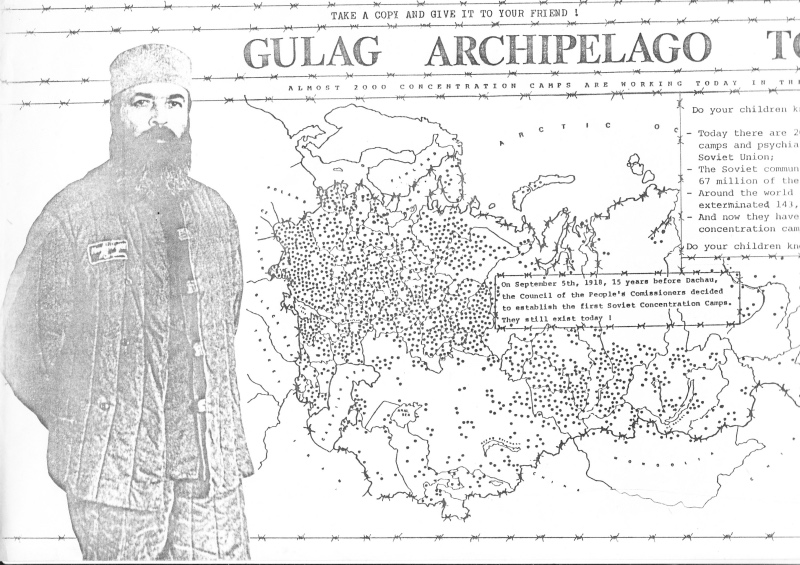
In an article first published on The Conversation, GUILLAUME TIBERGHIEN, of the University of Glasgow, looks at the growing trend of “dark tourism”, particularly when it comes to former Soviet gulags…
Dark tourism – involving travel to places historically associated with death and tragedy – is on the rise worldwide. Increasingly, this does not involve only visiting such places, but also witnessing certain performances of dark pasts.
Visitors can observe mock trials and prisoners receiving their sentences at prison museums, experience overnight stays in prison walls and watch historical reenactments of dark historical periods. In Kazakhstan, for example, on which my research has focused of late, visitors to gulag museums can witness scenes showcasing hard labour, bullying and violence, emotional and physical abuse. Performances of prison life are commonplace nowadays in gulag museums. Visitors can vividly imagine it all – the tears, pain and despair.

PICTURE: © Mikhail Makarenko, CC BY-SA
“As a major instrument of political repression, terror and control in the Soviet Union, estimates indicate that some 18 million people passed through the gulags between 1929 and the death of Stalin in 1953.”
The gulags (a bureaucratic acronym standing for Main Administration of Camps of the Soviet Union) dotted around Russia, the Baltic States and Kazakhstan are some of the most important Soviet penal institutions. They were a means of isolating and eliminating people who the system considered to be socially disruptive, suspicious and disloyal, as well as organising and demonstrating the superiority of the socialist penal system.
As a major instrument of political repression, terror and control in the Soviet Union, estimates indicate that some 18 million people passed through the gulags between 1929 and the death of Stalin in 1953.
More than 1.3 million people were deported to Kazakhstan from various parts of the Soviet Union. To acknowledge this, two gulag museums have recently opened in 2007 and 2011: Alzhir (Akmolinsk Camp for Wives of Traitors to the Motherland), which housed thousands of women, and Karlag, the former Karaganda Corrective Labour Camp.
Not usual museums
Since 2017, Alzhir and Karlag have organised a number of reenactment events showcasing what gulag life was like. The events are conducted by the museum staff, local military, school pupils and cultural staff.
During Soviet times, women in Alzhir were forced to work 10 or more hours a day and were often subject to mistreatment, including beating and rape. Those who had infants experienced the trauma of having their children taken from them at the age of four and sent to orphanages – if they did not die from hunger beforehand – driving women to despair and, for some of them, madness.
In line with this history, performances at Alzhir’s museum portray the arrival of women on the wagon that carried them to the camp, the removal of their children, and scenes of physical mistreatments inflicted by the camp guards. The performances are run by dozens of actors, including the museum management.
In Karlag, meanwhile, the annual “night at the museum” event is attended by 500-1,000 visitors. It involves a nighttime tour of the museum, with staff staging dramatic scenes from the history of the gulag. This can involve mock interrogation scenes and performances involving inmates hanging by their hands and being otherwise mistreated by the camp guards. Visitors are additionally offered “gulag-type meals”, and “volunteer” prisoners are asked not to sleep to mimic supposed life conditions.
Senior management of Karlag museum believe that such events mean visitors “can keep these memories of the museum for a long time”.
Voyeuristic curiosity?
These museums mostly attract local visitors. But tourism expert John Lennon – who coined the term dark tourism in the 1990s – believes that the sites could attract many Western visitors in the future: “There is plenty of evidence that people are interested and there is an important story there…They are places where visitors can learn about the enormous evil that was perpetrated across the Soviet Union…In an era of fake news and revisionism, such sites are hugely important.”
“What some people see as historical accuracy, others read as voyeuristic curiosity. Personally, I think it’s great that performances might increase visitation to the sites – but they will nonetheless remain contentious and voyeuristic if they only serve tourism purposes.”
This is good news. But as places of memory and commemoration, these museum practices are controversial to some historians and specialists of the gulag. The historian Steven Barnes, for example, has argued that they raise “significant moral questions about the acceptable limits in the portrayal of atrocity”. Museums that showcase these dark historical pasts are caught between the moral duty to offer tourism experiences that are historically accurate and the commercial desire to entertain visitors.
Such performances attempt to immerse visitors into the dark atmosphere of the epoch. By doing so, the museums hope to create a more personal connection to the tragedy. But such performances can be viewed as exploitative of victims, which can upset local communities and the descendants of victims. Some descendants of the victims told me that they experienced feelings of shame and guilt on witnessing these performances.
What some people see as historical accuracy, others read as voyeuristic curiosity. Personally, I think it’s great that performances might increase visitation to the sites – but they will nonetheless remain contentious and voyeuristic if they only serve tourism purposes.
These dark tourism practises – and similar ones around the world – certainly present a major challenge in terms of remembering and selectively interpreting a dark and difficult historical past.![]()
Guillaume Tiberghien is a lecturer in tourism (management/marketing) at the University of Glasgow. This article is republished from The Conversation under a Creative Commons license. Read the original article.





